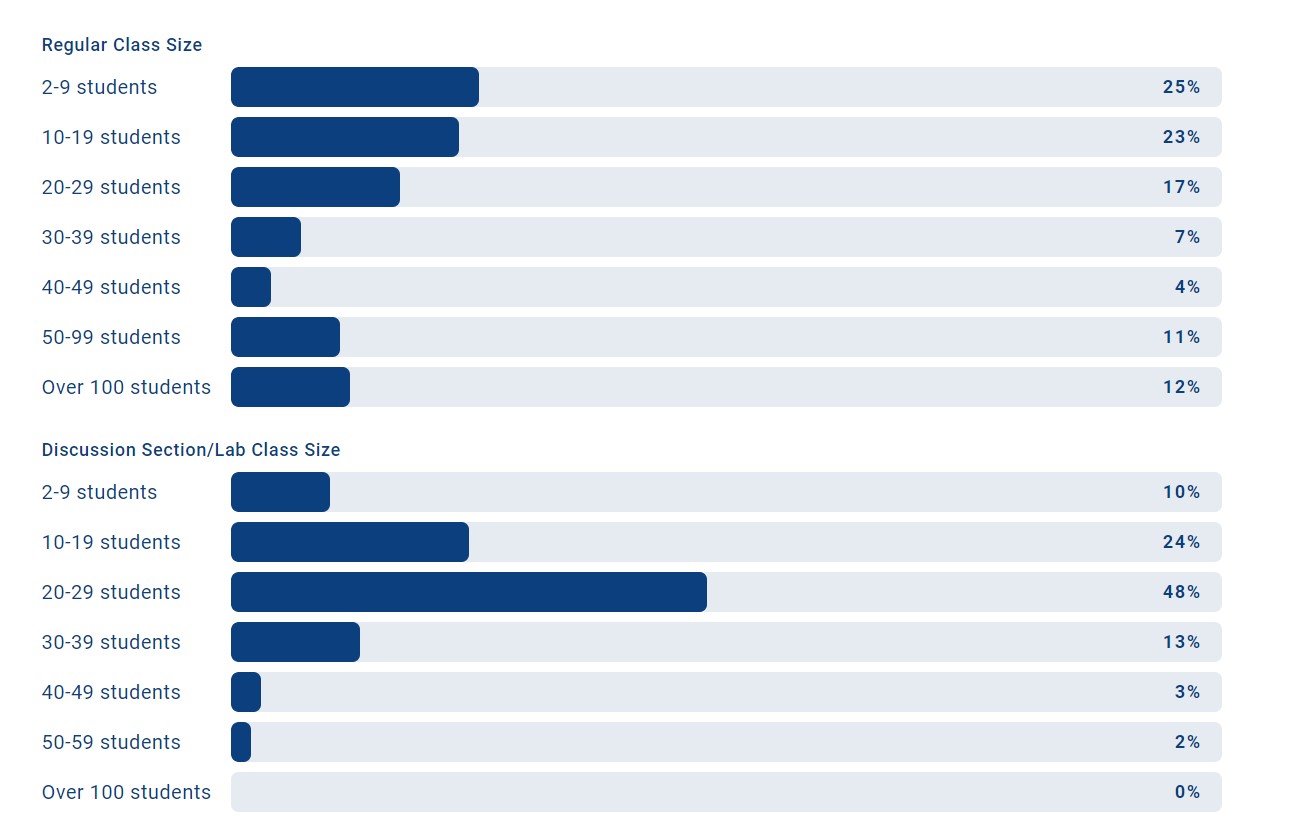College Sizes: Small, Medium, or Large?

The size of a college or university — its campus, its student body, and its academic programs — can definitely affect your college experience. Here are some different aspects of large colleges, small colleges, and medium-sized colleges to keep in mind as you make your college list.
How do you know what size college is best for you? A large university can feel overwhelming to some students, and exciting to others, while a small college can feel friendly, comfortable, or isolating, depending on who you ask. You might want the feel of a large university with thousands of fans cheering on the school team, or feel more at home chatting with a few friends over coffee on a campus where you know most students by name.
There are pros and cons to the size of college you choose, and it’s important to understand the ways in which large, small, and medium-sized schools differ and which qualities appeal to you — or don’t. This article will discuss various aspects of college size and how to decide what’s right for you.
Which Colleges Are Considered Small, Medium, or Large?
- According to the Carnegie Classification of colleges and universities, colleges considered "small" have fewer than 5,000 students. These are typically private colleges like Colgate, Grinnell, and Reed. Yet, it is entirely possible to find small public colleges, such as SUNY Geneseo and Delaware State University.
- Many colleges fall into the "medium" category, between 5,000 to 15,000 students. For example, Yale, Brown, Howard, Duke, University of Arkansas, University of Montana, and Binghamton University are all medium-sized.
- "Large" usually means more than 15,000 students. University of Southern California, New York University, and University of Pennsylvania qualify as large on the private side; UCLA, Michigan State, and University of Texas at Austin on the public side. A label of "huge" would be more accurate for those public universities that have more than 30,000 students, such as University of Michigan and University of California Berkeley.
You can look up the profiles of these and more than 2,600 colleges and universities using CollegeData’s College Search.
SOME PROS and COns OF SMALL Colleges and Large COLLEGES
What are some of the classic advantages and disadvantages of small, medium, and large colleges? Smaller schools, as a rule, are known for their tight-knit communities. You can get to know many people in a small school and see familiar faces whether you are in the library, the cafeteria, the quad, or in class. Because the community is small, it can be easier to develop long-lasting relationships with professors and staff. This doesn’t mean you can’t develop relationships with professors or be part of a tight-knit community at a large university — but it might be easier to do these things at a small college.
However, a smaller college may offer fewer academic majors and programs than a larger school, as well as fewer social opportunities, activities, and events. In a small, tight-knit community, you’re likely to see the same faces frequently, and it’s not so easy to avoid people you’d rather not see.
Large colleges are more likely than smaller colleges to have a wide variety of majors, research facilities, graduate schools, well-known faculty and Division I sports teams, and they can connect students with a large alumni network.
You are also more likely to find lecture-style classes at bigger schools — some with hundreds or even a thousand students. In these classes, it can be harder to get to know or stand out to professors and you’ll have competition when it comes to speaking up in class. Some large universities might be more bureaucratic when it comes to changing majors, adding/dropping classes, taking classes outside your major, and accessing advisory and academic support.
Many students find that medium-sized colleges have it all. They can be small enough to easily find friends and participate in social activities, and big enough to offer a large number of academic options. Some will have qualities of large universities and others will have more qualities of small colleges. But just like small and large colleges, they can vary widely in other ways, so be sure to do your due diligence and visit a few medium-sized schools, if you can.
College Size can be misleading
Some aspects of “big” and “small” colleges can be misleading. For example, the size of the undergraduate population at a large university may be much smaller than you think. Harvard University has a combined graduate and undergraduate student population of more than 20,000, but the undergraduate college has only about 6,600 students.
You might find large classes at any size college, especially in introductory courses. It’s helpful to look at the number of super large or very small classes you might encounter as an undergraduate to get a more realistic picture of what you might experience. You can find this information in many of CollegeData’s College Profiles, which you can access with our College Search tool. The College Profiles present the distribution of class sizes across undergraduate courses offered at the college, as well as average sizes of discussion sections and lab classes.
Below is data for UCLA reported for the 2022-2023 academic year. While UCLA would be considered a huge college with more than 30,000 undergraduates, students there encounter classes of all sizes.

How a small college can feel large and vice versa
Of course, it’s possible to find some of the advantages of a large college at a small school and vice versa. For example, universities featuring large lecture-style classes almost always include access to small-group discussions and review sessions where students, teaching assistants and professors can get to know each other. University honors programs may provide a small-class — and a small-college — environment as well. Smaller colleges might also feature large lecture-style classes, especially in introductory subjects.
Students often think that small colleges have limited social scenes, research opportunities or academic offerings. But some small schools join with other colleges and universities to provide more of these resources and experiences. For example, the seven Claremont Colleges in California, each with fewer than 3,000 students, and the 5 Colleges Consortium in Massachusetts, which includes the University of Massachusetts at Amherst with more than 24,000 students and four colleges with fewer than 5,000 students, share academic departments, cultural programs, research facilities, transportation, and libraries.
And when it comes to sports, big schools don’t have the lock on school spirit. Many small and medium-sized schools have intensely competitive rivalries with other colleges in their division and have students that passionately support their sports teams alongside the local community and alumni.
What’s The Perfect Size College for you?
Deciding among large, medium-sized and small colleges often comes down to the social environment you prefer. Knowing whether you feel more comfortable as "a small fish in a big pond" or a "big fish in a small pond" can help you decide. Do you like the idea of being known to a small community, or would you like to experience being anonymous among a throng of students? Your high school experience can also give you an idea of what you might like or not like in a small college or large college.
Other college qualities may be more important to you than student body size. If that's the case, you might put a mix of small, medium and large colleges on your application list. But if the number of students on campus or in a class significantly affects your comfort level, or certain aspects of a small college or big college experience appeal to you, put college size among your top college requirements. Then, if you can, validate your impressions by visiting colleges of different sizes, and keep an open mind. You might become more comfortable with a larger or smaller college as you explore and compare more campuses.
You can search for colleges by student body size and many other factors with CollegeData’s College Search.





